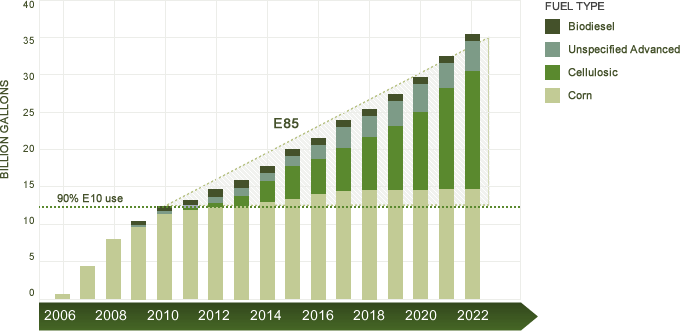Renewable Fuels Policy
Today, more than 80 percent of global oil reserves are limited to 10 countries, while biofuels made from sugarcane can be produced in more than 100 countries. First-generation biofuels are playing an important role in building consumer awareness and spurring capital investment in infrastructure and facilities that can be used for more promising second-generation biofuels.
In the U.S., Ford is a leader in providing vehicles that can operate on biofuels, and we will continue to produce vehicles capable of operating on biofuels in line with consumer demand and retail refueling infrastructure development. Our flexible-fuel products, which we are delivering at no additional cost to consumers, go well beyond requirements and what most other automakers are doing.
Ford’s vision for sustainable biofuels is for accelerated use of renewable fuels to deliver increased energy security, enhance economic development and help to address climate change. This vision includes rapidly expanding the number of vehicles that can operate on biofuels in some regions, increasing the number of stations offering biofuels, developing the fuel distribution network to support customer choice and value, and achieving technology breakthroughs to commercialize advanced biofuels.
Policies in several regions are aimed at increasing the use and availability of biofuels. The U.S. adopted a Renewable Fuel Standard requiring 36 billion gallons of biofuels by 2022, including more than 20 billion gallons of low-carbon advanced biofuels. The EU Renewable Energy Directive establishes a 10 percent renewable energy target for transportation energy in 2020, including the use of renewable-based electricity. The EU is also adding more-specific criteria regarding the types of sustainable biofuels that can be counted toward this regulation, and is aiming to limit the amount of crop-based biofuels used to meet the standard. Brazil has had a very aggressive domestic ethanol program for years.
But these policies aren’t enough. Providing value and refueling accessibility is critical to engage consumers and get them to use alternative energy sources. Hundreds of millions of vehicles in operation today were designed to use ethanol blends containing less than 10 percent ethanol, and our transportation energy infrastructure was set up to deliver petroleum-based fuels rather than high-concentration alcohols.
In January 2011, the U.S. Environmental Protection Agency (EPA) approved a waiver allowing the use of E15 (a blend of 85 percent gasoline and 15 percent ethanol) in 2001 and later model year vehicles, after previously issuing a waiver allowing E15 to be used in 2007 and later vehicles. Ford’s owner manuals are the source for our consumers to identify recommended fuels for use in their particular vehicle. As of the 2013 model year, Ford vehicles are capable of using E15, while prior model years are limited to E10.
On the one hand, we recognize the potential benefits of expanded use of E15 fuel in helping to build markets for renewable fuels in some countries. In addition, ethanol has an octane rating greater than today’s gasoline, so when the fuels are mixed, the resulting fuel blend will have higher octane than base gasoline. Typically, as the octane rating of a fuel increases, it reduces the tendency for “engine knock,” a condition that can, over time, lead to engine damage. (Today, however, while nearly all gasoline offered for sale to our vehicle owners at retail refueling stations across the U.S. is E10, this E10 has been reformulated so the benefits of increased octane rating from ethanol are no longer present.) Many of today’s advanced engines currently on the road are programmed to improve the efficiency of the engine just short of the point where the consumer would experience engine knock. For such engines, an increase in the octane rating of the fuel would result in improved vehicle efficiency. Further improvement to engine efficiency (through increased compression ratio and downsizing) could be achieved if manufacturers knew the octane rating of the fuel would be increased and made available to our customers across the nation.
On the other hand, the implementation of the EPA’s E15 waiver presents a number of concerns. In particular, Ford is concerned about the impact the waiver will have on the legacy fleet – the millions of vehicles still on the road that were designed to operate on E10 (or E0 for very old vehicles). Although E15 is not approved for use in such vehicles, there is a need to develop a robust program of regulation to prevent the “misfueling” of these vehicles. Without such a program, we anticipate a high incidence of misfueling, i.e., customers putting E15 fuel in vehicles not designed to use it. We are concerned that such vehicles will not continue to meet customer expectations for quality, durability and performance, as well as legal requirements to meet emission and on-board diagnostic regulations.
Because of these concerns, we believe that the risks for automakers, fuel providers and consumers need to be mitigated and addressed before proceeding with the widespread use of E15. The automobile industry has joined with other industries seeking to overturn the E15 waiver in federal court. We have suggested that the EPA and other policy makers develop a revised, prospective plan for the introduction of E15, in a way that better ensures the fuel is only used in vehicles designed to accommodate it.
In Europe, we recommend that biofuel use be harmonized throughout the region by targeting the introduction of B7 and E10 as standard fuels.
U.S. Renewable Fuel Standard











